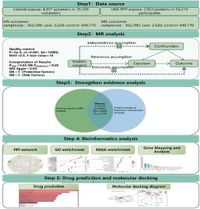In a pioneering study utilizing advanced Mendelian randomization (MR) and Bayesian analysis, researchers have identified three key plasma proteins—EVI5, OGA, and TNFRSF14—that could reshape treatment strategies for multiple sclerosis (MS), an inflammatory disease that poses significant global health challenges.
Multiple sclerosis, which predominantly affects young adults and compromises the central nervous system through immune attacks, continues to present substantial challenges in both treatment and prevention. From 1990 to 2016, global MS cases surged to over 2.2 million, with troubling geographic discrepancies in incidence rates. For instance, the prevalence in high-income North America stands at a staggering 164.6 cases per 100,000 people, contrasted with just 3.3 cases per 100,000 in eastern sub-Saharan Africa.
Despite the emergence of new therapeutic avenues like synthetic immunomodulators and monoclonal antibodies, the landscape remains daunting due to variability in treatment efficacy and adverse side effects. Establishing more targeted therapeutic approaches is essential. To pinpoint these new targets, the researchers integrated two large datasets of plasma protein quantitative trait loci (pQTLs) and conducted a comprehensive two-sample MR study that led to significant findings.
The study analyzed variants associated with the expression of plasma proteins and their correlation with MS, yielding identifiers crucial for future drug development. Among the proteins discovered, EVI5, OGA, and TNFRSF14 emerged as shared positive identifiers across datasets. The strength of these findings was bolstered by rigorous statistical analysis, including false discovery rate corrections and Bayesian co-localization methods.
Following extensive analysis, EVI5—a protein known to influence immune function and T-cell differentiation—showed significant expression in various tissues including the placenta and liver, highlighting its potential as a biomarker for MS. OGA and TNFRSF14 also surfaced as critical players in modulating immune responses and promoting myelin repair, core processes disrupted in MS pathology.
The implications of these findings are profound. With evidenced associations to multiple diseases and phenotypes—including autoimmune diseases and anxiety—these proteins may not only direct future therapeutic strategies but also provide new insights into MS's intricate pathology. Statistical associations indicate that regulating EVI5 may bolster myelin repair, while TNFRSF14's involvement in inflammatory response control could mitigate the neuroinflammatory processes characteristic of MS.
The study's rigorous methodologies underline the importance of comprehensive analysis in advancing the therapeutic landscape for MS. Employing genetic analyses alongside advanced bioinformatics approaches signifies a leap towards precision medicine in neurology. With the advent of combination therapies facilitated by EVI5, OGA, and TNFRSF14, the future of MS treatment holds promise—a prospect that could significantly enhance the quality of life for millions living with this debilitating condition.

